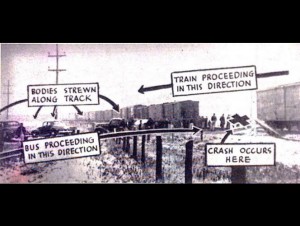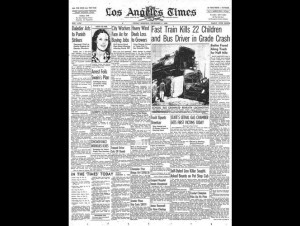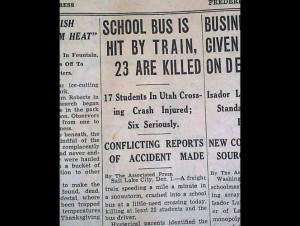Back when I began my training as a railroad engineer, I couldn’t help but be impressed with the well developed safety culture. It left what I saw from the food processing industry, that I had just come from, looking rudimentary by comparison. But, I thought it made sense that 180+ years of trial and error, learning from past disasters, and literally generations of refinement would evolve into a very mature safety culture.
Railroad terms such as “The Red Zone” used to describe the immediate area in front of, behind, and under a train that requires specific protocols to be adhered to, paint a graphic picture in my mind of how they got their names.
Breaking certain critical railroad safety rules would cause me to lose my engineer license immediately, as mandated by the FRA (Federal Railroad Administration). So I need to be constantly vigilant in the many procedures that can easily become routine, then mundane, and finally forgotten just once. For example, the average passenger has no idea how many different types, and how frequently, brake tests are performed on each train in service throughout the day. If I forget one of them just once, I’m decertified.
A common cliché, passed along as one engineer takes over the train from another is “Be safe”.
But with all of this talk about what we need to do to “Be safe”, what I fear the most are the safety rules broken by our passengers and by the public in general.
What I Fear:
Trespassers
Unlike how it’s depicted in movies and other media, railroad engineers don’t like seeing someone in our space along the railroad track. Our anti-social behavior of blasting our horn and radioing in for the police instead of the friendly wave like I just watched again on a “Rocky” movie is meant to save lives. This is trespassing into dangerous territory. People who do this sort of thing do not understand the dangers.
For one, there is an optical illusion in play. The size of the train makes it’s speed seem deceptively slower than it may be.
It’s impressive to me, that from a certain angle, how a large jumbo jet that is landing seem to just hang in the air over the ground. It seems to me that it is hardly even moving, when in reality even the latest and greatest 747 jumbo jet with full flaps and slats deployed, it’s slowest speed in the air is still moving at 125 mph. Our trains only go 79mph. But that’s too fast for an unsuspecting trespasser who has misjudged our speed to get out of the way. The shear mass and power of our trains plow the air like a fast moving winter plow in deep snow. The resulting “Wind wake” may suck you into the train rather than blow you away.
For the railroad engineer, is also the fear that the person in front of me on the track is there to end it all. Suicide by train is more common than most would think, and is only reported in the media when the resulting transit disruptions impact and cause delays to many people. Whether they are just being stupid or are there to end it all, we don’t like seeing anyone even close to our danger zone.
Railroad Crossings
Crossings at grade (where surface streets cross railroad tracks) is another possible area that can cause me some fear. As my train approaches our South Jordon Station from the north, I can’t help but notice a street that no longer crosses the railroad tracks. Back in 1938 this street had one of these “at grade crossings”.

The school bus driver, slowly moving through a bad winter blizzard with high winds and almost zero visibility had stopped here but still didn’t hear the train coming. The northbound Denver & Rio Grande Western hit that bus of 39 high school students, killing 22 of them as well as the bus driver. As the worst school bus – train accident in US history, this tragedy led to our nationwide laws requiring buses to stop at all railroad crossings and open the bus door so the driver can both look and listen for oncoming trains.


Now as my train moves through the many crossings in our railroad alignment, the biggest crossing hazard isn’t the bus driver who has been trained and is following the crossing safety rules that were written in blood, but the unwary other drivers who like to play Russian roulette.
I fear the impatient driver who has seen too many movies where a stunt driver beats the train in a spectacular fashion. But just as scary to me, is the timid driver who is slowly entering the crossing when the gates come down. Please know, timid driver, that if you become “trapped” by a lowered exit gate, do not stop on the tracks. The railroad wants you to keep on going through it. The gate was made to breakaway in such an event and can be repaired surprisingly quick.
Any time I’m approaching a crossing that is occupied by another passing train, I hope there isn’t someone on my tracks waiting for the train in front of them to get out of their way. They wouldn’t be looking my way or hear me coming. Worse than that is the impatient driver who darts in behind the passing train just as it clears the crossing. I might just then enter that same crossing on another track going 79 mph. The possibility of those same impatient drivers in heavy fog scare me for similar reasons.
Stations
In my work in the food industry, we would have never considered allowing the general public easy access to our heavy active machinery with nothing more that a yellow warning strip to protect them. But in reality, when our trains are entering the station, the potential for disaster is greater then in those manufacturing plants.

It seems that the more teens and young adults get together in social situations, the more they feel immortal, like nothing physically can hurt them. Their “bravery” scares me when my train is entering the station.
There’s a reason that horseplay is always banned in the first tenants of any workplace safety manual. This kind of rowdy behavior, which throws caution to the wind for just a few moments as part of having a good time, can turn a jovial carefree moment into a lifetime of regret and sorrow.
The curmudgeon in me comes out when a teenager’s attempt at flirting with his date includes pretending to shove his gal in front of the train and then saving her by pulling her back to safety. Darting in front of my approaching train in the station crosswalks, or bravely standing on the yellow caution strip and patting the railcars is dangerous. As my three quarters of a million pounds of machinery comes lumbering into the station, I may still be moving 30 mph while slowing to the proper stopping location. Their fool hardy antics scare me to death. As much as I’d want to, I can’t make a sudden stop to compensate for their miss-judgement. An emergency stop, where we dump all the brake system air and suddenly lock-up all the wheels on the train, will only stop the train 20% faster than our regular full service braking action. As the cliché goes, “It’s hard to stop a train.”
Rowdy teenagers, seeking a good time out on the town, aren’t the only ones who seem to miss the sense of potential danger as trains enter and leave the station. Too often, I am scared to death for small children whose parents are on break from parenting at the train station.
I know common parenting practice now days includes more reasoning with the child then forcing behavior on them, however personally, I’d like to see the child live long enough to learn the consequences before making poor safety choices, like testing their limits at the railroad station.
Once a few months ago, on my way to work, I was waiting for the train along with the other passengers including a mother and her tween son. The rambunctious boy ignored his mother’s pleas to stay off the edge of the platform and down by the track. By the time my curmudgeon self stepped in, the train was approaching the station. My rant began with, “Your mother is right…” and ended with a condensed version of if he slipped and fell over the edge, that train right there couldn’t stop in time and you would be ran over. I don’t know if it was my gruff old man voice or the official looking uniform, but that kid lived to ride another train.
On another occasion it was night time at our Salt Lake Central Station. This time I was waiting for my ride home. I watched as several young families also waited for their train. They seemed to be extended family with the several couples seated on the available benches while the dozen small children ran and played some sort of tag game. People watcher that I am, for the next ten minutes, I paid close attention to how these small children darted back and forth from edge to edge of the island platform we were on. It made me uneasy to see the younger ones of the group, toddlers, teetering on the edge next to the track as they played. None of the parents seemed to look up or notice anything about what their happily playing children were doing. The clanking of the train bell seem to alert everyone except these parents and their children. The adult talking continued as did the now dangerous tag game. By the time I was finished reacting to that one, I should probably call my self “The Curmudgeon” instead of “The Story Teller”. Am I the only one who senses danger?
As engineers departing the station, we look back in our mirrors to ensure all is safe behind us. Too often, I see a late would be passenger, running along the platform banging on the door trying to make a dramatic entry like they’ve seen in the old movies. One slip in the 8 inches between the platform and the moving train would be a gruesome scene for everyone there. This futile attempt to open the locked doors is not worth it. I’m thinking that it’s better that they kill 30 minutes waiting for the next train than themselves trying to get on this one.
My biggest scare
To finish my confessional, I’ll tell about the time I have been most afraid while driving the train. It was just a routine morning commute. I was headed south, picking up my regular passengers who ride the train to work everyday. These passengers are mostly seasoned commuters who know the pattern of rail traffic flow every morning and night. Some of them rarely look up as they flow like water, and stream 9onto the train and off again. And that’s why this story got so scary to me.
There had been switching problems up ahead which cause my train to meet another train in a station instead of our usual siding. I thought nothing of it when my train was routed into the east side of the platform instead of our usual west side. As I approached, my regular riders were approaching the station like they always do. My lights and bell were on as usual.
One man, approaching the crossing onto the station platform, had his ear phones in and his phone in his hands. This was normal, but I did make sure we had eye contact so he was aware I was there, coming into the station. He looked at me and then back down at his phone as he stopped walking right in front of the crossing. Moments later as my train just reached the crossing, with his head still down looking at his phone, he started walking again. As I slammed my hand down for the horn button, I didn’t know if I had hit him or not. Then the flash of his shocked face in my mirror told me he was as scared as I was.
Why did he do that? He knew I was there. We made eye contact and he had stopped. I have wondered about that many time since. Was he so used to me coming in on the other side that he somehow thought I was on the west side even though he saw me on the east side? His brain was focused on whatever was on his phone.
Habits and mussel memory are powerful things. That’s why you don’t even think about what you are doing when you work the controls in your car or when you turn on a light in your own house. I’ve learned to change what I normally do whenever there are small changes to my routine. Then I’m even more vigilant in looking out for the safety mistakes others might make. I don’t care if I look like and old curmudgeon for blasting my horn for no apparent reason. I’ll do whatever I can to make my train safe to be around.